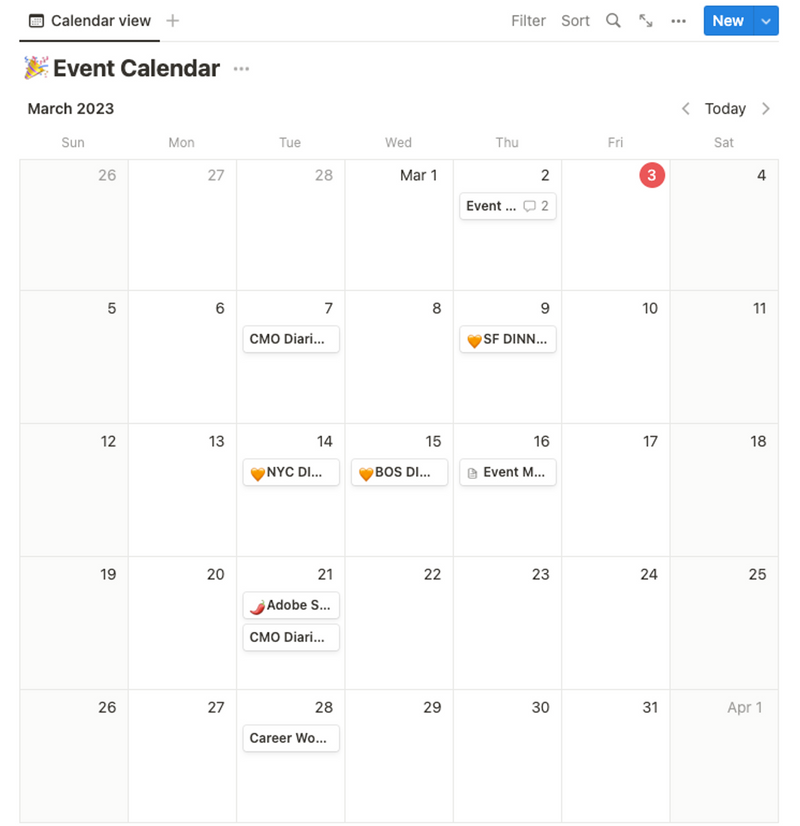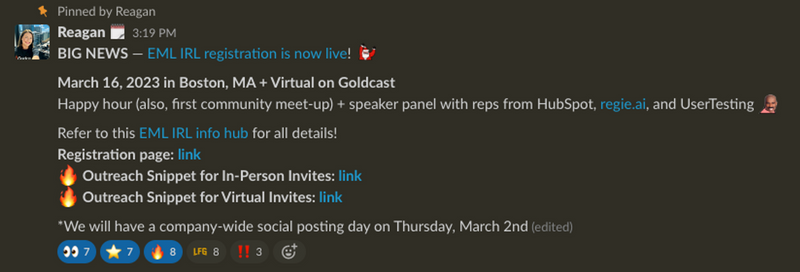Post-Webinar Operations: Aligning Marketing and Sales Teams for Success

Maximize Your Marketing ROI
Join 10,000 other marketers already getting the best tips on running engaging events that boost pipeline and create raving fans.
The Marketing team at Goldcast sprang into day four of Webinar Week with a behind-the-scenes strategic session on how we achieve Marketing and Sales alignment after our webinars.
Goldcast's Head of Growth, Kelly Cheng, and our Head of Business Development, Katie Morrissey, joined forces to break down how Goldcast aligns teams by building processes to share webinar data.
Our biggest tip? We feed actionable, real-time data to our Sales team in user-friendly formats and work toward seamless communication between Marketing and Sales.
Below, we dive into the top takeaways from the half-hour session. You can also watch the full session on-demand session for all the juicy details.
✨ Psst:You can unlock all of our Webinar Week content on-demand here
How can Marketing and Sales align before a webinar?
Getting the most from post-webinar alignment starts well before the event. At Goldcast, we've developed a system to make sure our marketing activities are accessible to everyone across the organization. Let’s break it down.
Pre-webinar tip #1: Create a team-wide event calendar
We like to use simple processes at Goldcast. This first tip is about as simple as they come, but oh so crucial to achieving alignment between Marketing and Sales.
Marketing developed a simple calendar to provide a single source for information related to upcoming events, including webinars.
The calendar is visible to everyone and includes everything Sales needs to know about the webinar and the type of prospects attending. It also serves as a handy reference to see email campaign schedules and all webinar marketing activities so the team can coordinate efforts.

Marketing also gathers and shares targeted promotional assets related to the webinar. They include plug-and-play resources like marketing graphics and videos for samples of promotions and sample copy snippets that Sales can use for emails and social media posts. Providing pre-written copy helps keep marketing messages consistent and helps to set up Sales for success.
🔥 Hot Tip: 93% of B2B marketers said they swear by LinkedIn to share content. Learn how to get in front of the right audience and drive more webinar registration through LinkedIn.
Pre-webinar tip #2: Hold regular Marketing and Sales syncs
We've been accused of oversharing at Goldcast, but we feel that regular communication between Marketing and Sales is the only way to a successful outcome.
How regular? A face-to-face meeting every two weeks seems to work best for us.
We are very intentional about what we accomplish with our syncs. For example, we start with a Marketing sub-department update where Sales can hear what direction Marketing is going and what they are learning about customer behavior. We found that by working toward total transparency, we can have Sales and Marketing working on the same team and getting excellent results.
The regular meetings provide a venue for Marketing to support Sales with suggestions on using the provided snippets on social media and other outreach activities. In addition, it's an opportunity to let Sales know about customer trends and data.
From the viewpoint of Sales, the bi-weekly meetings offer time to relate the quality of prospects Marketing is attracting. Face time allows each department to communicate concerns and, more importantly, share success stories and work together to improve results.
These regular meetings helped us achieve our goal of removing silos and creating transparency between Marketing and Sales.
Pre-webinar tip #3: Stay close with shared communication channels
Once every two weeks is great for getting together to prepare and plan a strategy for events, but to achieve proper alignment, the communication must be ongoing.
We use a shared Slack channel for updates and continual preparation. Communicating with your teams on a platform like Slack can help ensure everyone has the latest updates. It also gives both teams' members unlimited opportunities to ask questions and provide feedback.

What we like most about our Slack channel is that it allows us to share successes instantly. We use it to get the team excited and ready for success.
Everything we do in the pre-event stage leads to what we do after the webinar. Therefore, making sure Marketing and Sales are functioning as a unit before the event will lead you to success after the event.
How can we use data after a webinar?
The preparation leading to the webinar is part of your Breadcrumb Marketing efforts. You're aligning your teams for maximum effectiveness while teasing your content with your prospects.
Then the webinar happens. It's the turning point in the campaign. Now it's time to take the data you gather at the event and target it to your customers so Sales can relate to them in ways that will nurture them to the bottom of the funnel.
Now we'll look at some takeaways for getting the most from your post-webinar game plan.
Post-webinar tip #1: Integrate your marketing tech stack
All of our webinars are hosted on the Goldcast platform, so we take full advantage of the ability to gather data through our webinars. Goldcast captures 16 unique data points about each attendee. Take a look!

We've put a lot of effort into building an integrated tech stack that takes our webinar data and pushes it to both our marketing automation platform (MAP) and customer relationship management (CRM).
Tracking multiple data points allows us to build richer customer profiles so Sales can reach prospects at the right time with a deeper level of understanding.

By integrating our MAP and CRM, we can easily direct data from webinars to Sales without lag time. It gives Sales what they need most:
- Speed to lead
- Personalization
- Meeting people where they are
🔥 Hot Tip: One of the best ways we've found of meeting these needs is with an integration of Slack and Salesforce. We use it to provide real-time event updates to our Sales staff. Instant notifications let them jump into the chats during live events equipped with all the data needed to reach out to prospects personally.
Post-webinar Takeaway #2: Segment webinar lists for follow-up
The data you gather at webinars allows you to segment your database and personalize your follow-up. Your participants have already filled out a form, which provides basic contact and company information.
Goldcast allows organizers to segment registrants easily based on attendance status. So, you can send custom messaging to people who did attend versus those who didn’t.
You can take this a step further by enriching this data with engagement actions. For example, poll responses and questions asked during the webinar provide a wealth of information around what’s top of mind for attendees. You can then use this information for highly targeted follow-ups for your top prospects.

For example, we typically ask a question related to the webinar topic or a relevant challenge attendee might encounter. All poll data is fed into the attendee’s Salesforce profile, which enables the Sales team to personalize their outreach after the webinar.
Getting that information that reveals characteristics and preferences helps determine how Sales will approach the prospect and lead them along the process. In addition, having a point of human connection can sometimes bridge the gap and help them into the fold.
Post-webinar Takeaway #3: Build a shared performance dashboard
Your data is more valuable if it's in an easily scannable format. Sifting through data tables is too slow, but putting information into a graphic form solves the problem.
We've used Goldcast, Hubspot, and Salesforce to build an integrated live dashboard to find our events' return on investment (ROI). We custom-built this dashboard to provide intuitive and up-to-the-minute insights about our webinars.

Was it easy? No, it took some time to get it right. You can do the same thing using KPIs specific to your situation. It is also good to collect different data points to glean as much information as possible.
With today's tools, taking your raw datasets and presenting them to gain value is becoming more accessible. For example, in the webinar world, we want to see how many people registered vs. how many attended. Do people prefer the live event or the on-demand version?
A dashboard gives you a bird's eye view of your metrics and helps you to track trends over time. In addition, we use it to understand better how our webinars impact our sales funnel and pipeline.
Find more strategy-filled video sessions.
We hope these takeaways inspire you to align your teams and use webinar event data to its fullest. For more insight on performance, check out our free B2B Webinar Benchmark Report.

Transform Your Video Marketing with AI
Stay In Touch
Platform
Resources
© 2025 Copyright Goldcast, Inc. All rights reserved.





 Upcoming Events
Upcoming Events Event Series
Event Series On-Demand Events
On-Demand Events

